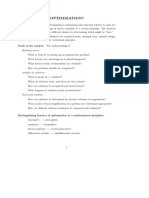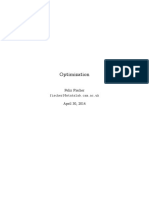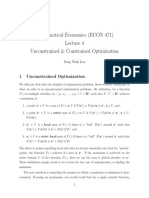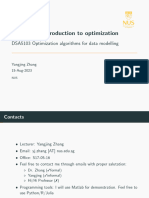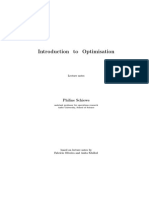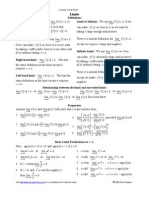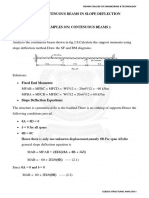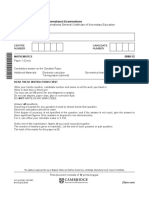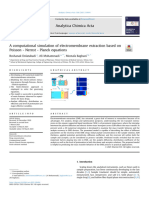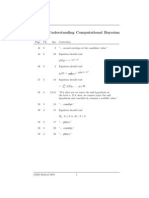Introduction to
Optimization
(Part 1)
Daniel Kirschen
�Economic dispatch problem
Several generating units serving the
load
What share of the load should each
generating unit produce?
Consider the limits of the generating
units
Ignore the limits of the network
2011 D. Kirschen and University of
Washington
�Characteristics of the generating units
T
J/h
Input
Fuel
Electric Power
(Input)
(Output)
Pmax
Pmin
MW
Thermal generating units
Output
Consider the running costs only
Input / Output curve
Fuel vs. electric power
Fuel consumption measured by its energy content
Upper and lower limit on output of the generating unit
2011 D. Kirschen and University of Washington
�Cost Curve
Multiply fuel input by fuel cost
No-load cost
Cost of keeping the unit running if it could produce
zero MW
Cost
$/h
No-load cost
MW
Pmax
Pmin
2011 D. Kirschen and University of
Washington
Output
�Incremental Cost Curve
Incremental cost curve
Cost [$/h]
FuelCost vs Power
Power
Derivative of the cost curve
In $/MWh
Cost of the next MWh
F
P
MW
Incremental Cost
[$/MWh]
MW
2011 D. Kirschen and University of
Washington
�Mathematical formulation
Objective function
C CA (PA ) CB (PB ) CC (PC )
Constraints
Load / Generation balance:
L PA PB PC
Unit Constraints:
PAmin PA PAmax
PBmin PB PBmax
PCmin PC PCmax
2011 D. Kirschen and University of
Washington
This is an optimization problem
6
�Introduction to Optimization
�An engineer can do with one dollar
which any bungler can do with two
A. M. Wellington (1847-1895)
2011 D. Kirschen and University of
Washington
�Objective
Most engineering activities have an
objective:
Achieve the best possible design
Achieve the most economical operating
conditions
This objective is usually quantifiable
Examples:
minimize cost of building a transformer
minimize cost of supplying power
minimize losses in a power system
maximize profit from a bidding strategy
2011 D. Kirschen and University of
Washington
�Decision Variables
The value of the objective is a
function of some decision variables:
F f x1 , x2 , x3 , .. xn
Examples of decision variables:
Dimensions of the transformer
Output of generating units, position of
taps
Parameters of bids for selling electrical
energy
2011 D. Kirschen and University of
Washington
10
�Optimization Problem
What value should the decision
F ftake
, x3that
, .. xn
x1, x2so
variables
is minimum or maximum?
2011 D. Kirschen and University of
Washington
11
�Example: function of one
variable
f(x*)
f(x)
x*
f(x)ismaximumforx=x*
2011 D. Kirschen and University of Washington
12
�Minimization and
Maximization
f(x*)
f(x)
x*
f(x)
f(x*)
Ifx=x*maximizesf(x)thenitminimizesf(x)
2011 D. Kirschen and University of Washington
13
�Minimization and Maximization
maximizing f(x) is thus the same
thing as minimizing g(x) = -f(x)
Minimization and maximization
problems are thus interchangeable
Depending on the problem, the
optimum is either a maximum or a
minimum
2011 D. Kirschen and University of
Washington
14
�Necessary Condition for
Optimality
f(x )
*
f(x)
df
0
dx
df
0
dx
x*
If x x * maximises f ( x) then:
df
f ( x) f ( x ) for x x
0 for x x *
dx
*
df
f ( x) f ( x ) for x x
0 for x x *
dx
*
2011 D. Kirschen and University of Washington
15
�Necessary Condition for
Optimality
df
0
dx
f(x)
x*
df
If x x maximises f ( x) then
0 for x x *
dx
*
2011 D. Kirschen and University of Washington
16
�Example
f(x)
df
Forwhatvaluesofxis ?
0
dx
Inotherwords,forwhatvaluesofxisthenecessaryconditionfor
optimalitysatisfied?
2011 D. Kirschen and University of Washington
17
�Example
f(x)
A, B, C, D are stationary points
A and D are maxima
B is a minimum
C is an inflexion point
2011 D. Kirschen and University of
Washington
18
�How can we distinguish minima and
maxima?
f(x)
For x A and x D, we have:
d2 f
dx
Theobjectivefunctionisconcavearoundamaximum
2011 D. Kirschen and University of Washington
19
�How can we distinguish minima and
maxima?
f(x)
For x B we have:
d2 f
dx
Theobjectivefunctionisconvexaroundaminimum
2011 D. Kirschen and University of Washington
20
�How can we distinguish minima and
maxima?
f(x)
For x C, we have:
d2 f
dx
Theobjectivefunctionisflataroundaninflexionpoint
2011 D. Kirschen and University of Washington
21
�Necessary and Sufficient Conditions of
Optimality
df
Necessary condition:
0
dx
Sufficient condition:2
For a maximum:
d f
0
2
dx
For a minimum:
d2 f
0
2
dx
2011 D. Kirschen and University of
Washington
22
�Isnt all this obvious?
Cant we tell all this by looking at the
objective function?
Yes, for a simple, one-dimensional case
when we know the shape of the
objective function
For complex, multi-dimensional cases
(i.e. with many decision variables) we
cant visualize the shape of the
objective function
We must then rely on mathematical
techniques
2011 D. Kirschen and University of
Washington
23
�Feasible Set
The values that the decision
variables can take are usually limited
Examples:
Physical dimensions of a transformer
must be positive
Active power output of a generator may
be limited to a certain range (e.g. 200
MW to 500 MW)
Reactive power output of a generator
may be limited to a certain range (e.g.
-100 MVAr to 150 MVAr)
2011 D. Kirschen and University of
Washington
24
�Feasible Set
f(x)
xMIN
xMAX
FeasibleSet
Thevaluesoftheobjectivefunctionoutside
thefeasiblesetdonotmatter
2011 D. Kirschen and University of Washington
25
�Interior and Boundary
Solutions
f(x)
xMIN
xMAX
A and D are interior maxima
B and E are interior minima
XMIN is a boundary minimum Do not satisfy the
XMAX is a boundary maximumOptimality conditions!
2011 D. Kirschen and University of Washington
26
�Two-Dimensional Case
f(x1,x2)
x1*
x2*
x2
2011 D. Kirschen and University of Washington
x1
f(x1,x2)isminimumforx1*,x2*
27
�Necessary Conditions for Optimality
f(x1,x2)
f ( x1 ,x2 )
x1
0
x* ,x*
1 2
f ( x1 ,x2 )
x2
x* ,x*
1 2
x1*
x2*
x2
2011 D. Kirschen and University of Washington
x1
28
�Multi-Dimensional Case
Atamaximumorminimumvalueof f x1 , x2 , x3 , .. xn
wemusthave:
f
0
x1
f
0
x 2
f
0
x n
Apointwheretheseconditionsaresatisfiediscalledastationarypoint
2011 D. Kirschen and University of Washington
29
�Sufficient Conditions for
Optimality
f(x1,x2)
minimum
maximum
x1
x2
2011 D. Kirschen and University of Washington
30
�Sufficient Conditions for
Optimality
f(x1,x2)
Saddlepoint
x1
x2
2011 D. Kirschen and University of Washington
31
�Sufficient Conditions for
Optimality
CalculatetheHessianmatrixatthestationarypoint:
2 f
x 2
1
2 f
x2 x1
2 f
xn x1
2011 D. Kirschen and University of Washington
2 f
x1 x 2
2 f
x 22
2 f
xn x 2
2 f
x1 x n
2
f
x2 x n
2 f
2
xn
32
�Sufficient Conditions for
Optimality
Calculate the eigenvalues of the Hessian matrix
at the stationary point
If all the eigenvalues are greater or equal to zero:
The matrix is positive semi-definite
The stationary point is a minimum
If all the eigenvalues are less or equal to zero:
The matrix is negative semi-definite
The stationary point is a maximum
If some or the eigenvalues are positive and other
are negative:
The stationary point is a saddle point
2011 D. Kirschen and University of
Washington
33
�Contours
f(x1,x2)
F2
F1
x1
F1
x2
2011 D. Kirschen and University of Washington
F2
34
�Contours
Acontouristhelocusofallthepointthatgivethesamevalue
totheobjectivefunction
x2
2011 D. Kirschen and University of Washington
Minimumormaximum
x1
35
�Example 1
Minimise C x12 4 x 22 2 x1 x2
Necessary conditions for optimality:
C
2 x1 2 x 2 0
x1
C
2 x1 8 x2 0
x 2
2011 D. Kirschen and University of Washington
x1 0
x 2 0
isastationary
point
36
�Example 1
Sufficientconditionsforoptimality:
2C
x 2
1
Hessian Matrix:
2C
x 2 x1
2C
x1 x2
2 C
x22
2 2
2 8
mustbepositivedefinite(i.e.alleigenvaluesmustbepositive)
2
2
0 2 10 12 0
2
8
=
10 52
0
2
2011 D. Kirschen and University of Washington
Thestationarypoint
isaminimum
37
�Example 1
x2
C=9
C=1
C=4
x1
Minimum:C=0
2011 D. Kirschen and University of Washington
38
�Example 2
Minimize C x12 3x22 2x1 x2
Necessary conditions for optimality:
C
2x1 2x2 0
x1
x1 0
C
x 2 0
2x1 6x2 0
x2
2011 D. Kirschen and University of Washington
isastationary
point
39
�Example 2
Sufficientconditionsforoptimality:
2C
x 2
1
Hessian Matrix:
2C
x 2 x1
2C
x1 x2
2
C
2
x2
2 2
2 6
2 2
0 2 4 8 0
2 6
4 80
=
0
2
or =
80
2
2011 D. Kirschen and University of Washington
Thestationarypoint
isasaddlepoint
40
�Example 2
x2
C=0
C=9
C=4
C=1
C=9
C=4
C=4
C=1
C=9
x1
C=1
C=4
C=9
This stationary point is a saddle point
2011 D. Kirschen and University of Washington
C=0
41
�Optimization with
Constraints
�Optimization with Equality
Constraints
There are usually restrictions on the
values that the decision variables
can take
Minimise
f x1 , x2 ,.. , xn
Objectivefunction
subject to:
1 x1 , x2 ,.. , xn 0
Equalityconstraints
m x1 , x2 ,.. , xn 0
2011 D. Kirschen and University of
Washington
43
�Number of Constraints
N decision variables
M equality constraints
If M > N, the problems is overconstrained
There is usually no solution
If M = N, the problem is determined
There may be a solution
If M < N, the problem is underconstrained
There is usually room for optimization
2011 D. Kirschen and University of
Washington
44
�Example 1
Minimise f x1 , x 2 0.25 x12 x22
x2
Subject to x1 , x 2 5 x1 x 2 0
x1 , x2 5 x1 x 2 0
Minimum
x1
f x1 , x2 0.25 x12 x 22
2011 D. Kirschen and University of Washington
45
�Example 2: Economic
Dispatch
G1
x1
G2
x2
C1 a1 b1 x12
Costofrunningunit1
C 2 a2 b2 x 22
Costofrunningunit2
C C1 C 2 a1 a2 b1 x12 b2 x 22
Totalcost
Optimizationproblem:
Minimise C a1 a2 b1 x12 b2 x 22
Subject to: x1 x 2 L
2011 D. Kirschen and University of Washington
46
�Solution by substitution
Minimise C a1 a2 b1 x12 b2 x 22
Subject to: x1 x 2 L
x2 L x1
C a1 a2 b1 x12 b2 L x1
Unconstrainedminimization
dC
2 b1 x1 2 b2 L x1 0
dx1
b2 L
x1
b1 b2
d2 C
2
1
dx
2011 D. Kirschen and University of Washington
b1 L
x 2
b1 b2
2b1 2 b2 0 minimum
47
�Solution by substitution
Difficult
Usually impossible when constraints
are non-linear
Provides little or no insight into
solution
Solution using Lagrange multipliers
2011 D. Kirschen and University of
Washington
48
�Gradient
Consider a function f (x1 , x2 ,.. , xn )
The gradient of f is the vector f
2011 D. Kirschen and University of
Washington
f
x1
f
x2
xn
49
�Properties of the Gradient
Each component of the gradient
vector indicates the rate of change of
the function in that direction
The gradient indicates the direction
in which a function of several
variables increases most rapidly
The magnitude and direction of the
gradient usually depend on the point
considered
At each point, the gradient is
perpendicular to the contour of the
2011 D. Kirschen and University of
Washington
50
�Example 3
f ( x, y) ax 2 by 2
f
x 2 ax
f
f
2 by
y
y
B
C
A
x
D
2011 D. Kirschen and University of Washington
51
�Example 4
f ( x, y) ax by
f
x
f
f
y
a
b
f f3
f f2
f f1
f
f
2011 D. Kirschen and University of Washington
52
�Lagrange multipliers
Minimise f x1 , x 2 0.25 x12 x22 subject to x1 , x 2 5 x1 x2 0
x1 , x2 5 x1 x 2
f 0.25 x12 x 22 6
f 0.25 x12 x 22 5
2011 D. Kirschen and University of Washington
53
�Lagrange multipliers
f
x1
f
x 2
f x1 , x2 6
f x1 , x2 5
f
f
2011 D. Kirschen and University of Washington
54
�Lagrange multipliers
x1 , x2
x1
x 2
f x1 , x2 6
f x1 , x2 5
2011 D. Kirschen and University of Washington
55
�Lagrange multipliers
Thesolutionmustbeontheconstraint
x1 , x2
Toreducethevalueoff,wemustmove
inadirectionoppositetothegradient
f
f x1 , x2 6
f x1 , x2 5
A
?
f
B
2011 D. Kirschen and University of Washington
56
�Lagrange multipliers
x1 , x2
Westopwhenthegradientofthefunction
isperpendiculartotheconstraintbecause
movingfurtherwouldincreasethevalue
ofthefunction
f
f x1 , x2 6
f x1 , x2 5
Attheoptimum,thegradientofthe
functionisparalleltothegradient
oftheconstraint
2011 D. Kirschen and University of Washington
57
�Lagrange multipliers
Attheoptimum,wemusthave: f
Whichcanbeexpressedas:
f 0
Intermsofthecoordinates:
0
x1
x1
f
0
x 2
x 2
Theconstraintmustalsobesatisfied: x1 , x2 0
iscalledtheLagrangemultiplier
2011 D. Kirschen and University of Washington
58
�Lagrangian function
Tosimplifythewritingoftheconditionsforoptimality,
itisusefultodefinetheLagrangianfunction:
x
1 , x2 , f x1 , x2 x1 , x2
Thenecessaryconditionsforoptimalityarethengiven
bythepartialderivativesoftheLagrangian:
x1 , x 2 ,
x1
x1 , x 2 ,
x 2
x1 , x 2 ,
2011 D. Kirschen and University of Washington
0
x1
x1
f
0
x2
x 2
x1 , x2 0
59
�Example
Minimise f x1 , x 2 0.25 x12 x22 subject to x1 , x 2 5 x1 x2 0
x
1 , x2 , 0.25 x12 x22 5 x1 x2
x1 , x 2 ,
x1
x1 , x 2 ,
x 2
x1 , x 2 ,
0.5 x1 0
2 x2 0
5 x1 x 2 0
2011 D. Kirschen and University of Washington
60
�Example
x1 , x 2 ,
x1
x1 , x 2 ,
x 2
x1 , x 2 ,
0.5 x1 0
x1 2
2 x2 0
1
x2
2
5 x1 x 2 0
1
5 2 0
2
2
x1 4
x2 1
2011 D. Kirschen and University of Washington
61
�Example
x2
Minimise f x1 , x 2 0.25 x12 x22
Subject to x1 , x 2 5 x1 x 2 0
x1 , x2 5 x1 x 2 0
f x1 , x2 5
Minimum
x1
4
2011 D. Kirschen and University of Washington
62
�Important Note!
Iftheconstraintisoftheform:
ax1 bx 2 L
ItmustbeincludedintheLagrangianasfollows:
= f x1 ,.. , xn L ax1 bx2
Andnotasfollows:
= f x1 ,.. , xn ax1 bx2
2011 D. Kirschen and University of Washington
63
�Application to Economic
Dispatch
G1
x1
G2
x2
minimise f x1 , x 2 C1 x1 C 2 x 2
s.t. x1 , x2 L x1 x 2 0
x
1 , x2 , C1 x1 C 2 x2 L x1 x2
dC1
0
x1 dx1
dC 2
0
x 2 dx 2
L x1 x 2 0
2011 D. Kirschen and University of Washington
dC1
dx1
dC 2
dx2
Equalincrementalcost
solution
64
�Equal incremental cost
solution
Costcurves:
C1 ( x1 )
C 2 ( x2 )
x1
Incremental
costcurves:
x2
dC 1
dC 2
dx1
dx 2
2011 D. Kirschen and University of Washington
x1
x652
�Interpretation of this
solution
dC 1
dC 2
dx1
dx 2
x1*
L
x1
x2*
Lx x
*
1
2011 D. Kirschen and University of Washington
x2
*
2
If<0,reduce
If>0,increase
66
�Physical interpretation
C
lim
dx x0 x
dC
C( x)
For x sufficiently small:
dC
C
x
dx
If x 1 MW :
dC
C
dx
dC(x)
dx
x
2011 D. Kirschen and University of Washington
Theincrementalcostisthecostof
oneadditionalMWforonehour.
Thiscostdependsontheoutputof
thegenerator.
67
�Physical interpretation
dC1
: Cost of one more MW from unit 1
dx1
dC 2
: Cost of one more MW from unit 2
dx2
dC1 dC 2
Suppose that
dx1 dx 2
dC1
Decrease output of unit 1 by 1MW decrease in cost =
dx1
dC 2
Increase output of unit 2 by 1MW increase in cost =
dx 2
dC 2 dC1
Net change in cost =
0
dx2 dx1
2011 D. Kirschen and University of Washington
68
�Physical interpretation
Itpaystoincreasetheoutputofunit2anddecreasethe
outputofunit1untilwehave:
dC1
dx1
dC 2
dx2
TheLagrangemultiplieristhusthecostofonemoreMW
attheoptimalsolution.
Thisisaveryimportantresultwithmanyapplicationsin
economics.
2011 D. Kirschen and University of Washington
69
�Generalization
Minimise
f x1 , x2 ,.. , xn
subject to:
1 x1 , x2 ,.. , xn 0
m x1 , x2 ,.. , xn 0
Lagrangian:
= f x1 ,.. , xn 1 1 x1 ,.. , xn m m x1 ,.. , xn
OneLagrangemultiplierforeachconstraint
n+mvariables:x1,,xnand1,,m
2011 D. Kirschen and University of Washington
70
�Optimality conditions
= f x1 ,.. , xn 1 1 x1 ,.. , xn m m x1 ,.. , xn
1
m
f
1
m
0
x1 x1
x1
x1
nequations
1
m
f
1
m
0
x n x n
x n
x n
1 x1 ,, xn 0
1
m x1 ,, xn 0
m
2011 D. Kirschen and University of Washington
mequations
n+mequationsin
n+mvariables
71



























